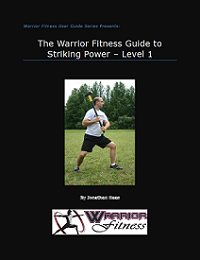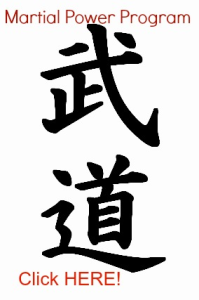Principles of Striking Power
1. Whole Body Power
All movement happens in real life happens in three dimensions, so why train exercises that only incorporate one or two? Training muscles in isolation, unless it is used to rehab a specific injury, range of motion, or strengthen a particular muscle to add to the whole, does not work in martial art. With very few special exceptions, the majority of exercises in this manual will train movements in three dimensions utilizing diagonal, rotary, and angular strength, not muscles. As discussed above, this is the goal of SPP – neurological adaptation.
2. Stored Elastic Energy (SEE)
Stored Elastic Energy is basically the potential energy stored in tendons and connective tissue as a way to power movement. An easy exercise to begin to feel stored elastic energy is to stand in a natural stance with feet shoulder width apart. Bend your right arm and raise it up to shoulder height as if you were about to throw the most telegraphed punch in history (don’t worry, it’s just an exercise). Now, lead from the elbow and pull your fist back. Allow your torso to rotate, but keep the feet planted and the hips facing forward. When you reach the end of your range of motion, hang out there for a second and feel the tension (torque) on the spine. Now simply relax and release that torque to throw the punch. Don’t add any driving forces with muscle. You can’t propel it any faster; you’ll just slow it down. Feel it? Try it again. Do it with the other arm. Remember the feeling. This is stored elastic energy (SEE). This point here about creating torque or stored elastic energy (SEE) in the spine is essential in being able to move powerfully without winding up or telegraphing the movement. If you are having trouble feeling it, try to exaggerate the movement. Make it much larger than necessary to study the feeling. It should feel like a tension in the lower back near the bottom of the spine. When this tension (torque) is relaxed (released), the movement happens.
3. Structure / Kamae
Many people tend to use the terms alignment and structure almost interchangeably but in actuality, alignment is a component of structure. For example, looking at a natural standing posture, good alignment would be:
- Crown up
- Chin down
- Shoulders packed down
- Spine lifting up (through crown)
- Spine pulling down (through the sacrum)
- Hips under shoulders
- Knees under hips
- Mid-foot balance
- Chest is relaxed
- Butt not sticking out
- Hips are open
- Knees are over the toes
- Weight evenly distributed (50/50)
- No leaning forward or backward
This puts the whole body into proper alignment. Structure also includes (in my lexicon) the balance of tensions within the body’s soft tissues. Think of spine as the mast of a sail boat while the soft tissues (fascia) act as the stays keeping the tensional balance.
4. Breathing
How often do you think about breathing as it relates to striking? Yet it is absolutely essential to maintain proper breathing when in combat or simply hitting a heavy bag, mitt, or an opponent. Lack of breath control affects the rest of your body and hinders your overall performance.
This article is from my e-book manual, Warrior Fitness Guide to Striking Power.
Want to learn even more about how to bring together fitness training with your martial art practice for vast performance improvement? Join me on a 6-week journey where I take you behind the curtain and show you how to build Martial Power!






Leave A Response